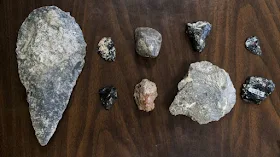Ανακάλυψη στην ανατολική Αφρική. The first evidence of human life in the Olorgesailie Basin comes from about 1.2 million years ago. For hundreds of the thousands of years, people living there made and used large stone-cutting tools called handaxes (left). According to three new studies published in Science, early humans in East Africa had--by about 320,000 years ago--begun using color pigments and manufacturing more sophisticated tools (right) than those of the Early Stone Age handaxes, tens of thousands of years earlier than previous evidence has shown in eastern Africa. The sophisticated tools (right) were carefully crafted and more specialized than the large, all-purpose handaxes (left). Many were points designed to be attached to a shaft and potentially used as projectile weapons, while others were shaped as scrapers or awls. The National Museums of Kenya loaned the artifacts pictured above to conduct the analyses published in Science. Credit: Human Origins Program, Smithsonian
Οι
πρόγονοι του συγχρόνου ανθρώπου (Homo
sapiens) που ζούσαν στην Ανατολική Αφρική, είχαν αρχίσει, ήδη πριν από
320.000 χρόνια, αρκετά νωρίτερα από ό,τι πίστευαν έως τώρα οι επιστήμονες, να
κάνουν μια σειρά από τεχνικές και κοινωνικές καινοτομίες.
The research team
also discovered black and red rocks--manganese and ocher--at the sites, along
with evidence that the rocks had been processed for use as coloring material.
"We don't know what the coloring was used on, but coloring is often taken
by archeologists as the root of complex symbolic communication," Potts
said. "Just as color is used today in clothing or flags to express
identity, these pigments may have helped people communicate membership in
alliances and maintain ties with distant groups." The National Museums of
Kenya loaned the materials pictured above to conduct the analyses published in
Science. Credit: Human Origins Program, Smithsonian
Ανάμεσα
στις καινοτομίες ήταν να κατασκευάζουν πιο καλοφτιαγμένα και πιο κοφτερά λίθινα
εργαλεία (πολλά από μαύρο ηφαιστειακό οψιδιανό και από έγχρωμο πυριτόλιθο), να
χρησιμοποιούν χρωστικές ουσίες από ώχρα και μαγγάνιο (για άγνωστη χρήση αλλά
μάλλον για βάψιμο του σώματος με φωτεινό κόκκινο χρώμα ή για άλλους συμβολικούς
σκοπούς), καθώς επίσης να κάνουν μακρινές μετακινήσεις και πιθανώς εμπορικές
ανταλλαγές σε αποστάσεις έως 90 χιλιομέτρων.
Assortment of Early
and Middle Stone Age tools found in the Olorgesailie Basin, Kenya. The tool at
left is a hand axe. Jay Reed/NPR
Όπως
τα σημερινά κινητά τηλέφωνα είναι μικρότερα από ό,τι τα πρώτα κινητά που
εμφανίσθηκαν, έτσι και τα νέα λίθινα εργαλεία (χειροπελέκεις κ.α.) ήσαν
μικρότερα, πιο εύχρηστα και πιο αποτελεσματικά από τα παλαιότερα. Επιπλέον,
ήσαν φτιαγμένα όχι από ντόπιες πέτρες, αλλά από πιο εξωτικές πρώτες ύλες που
είχαν μεταφερθεί από μακρινά μέρη, μια ένδειξη για την ύπαρξη ακόμη και πρώιμων
εμπορικών δικτύων.
In this
Olorgesailie Basin excavation site, red ocher pigments were found with Middle
Stone Age artifacts. This is the earliest evidence of the extraction and use of
pigments among ancient humans. Credit: Human Origins Program, Smithsonian
Οι
καινοτομίες αυτές συνέπεσαν με μεγάλες περιβαλλοντικές και οικολογικές αλλαγές
την ίδια εποχή σε αυτή την περιοχή. Αυτό ενισχύει την πεποίθηση των επιστημόνων
ότι οι αλλαγές στην ανθρώπινη συμπεριφορά σε μεγάλο βαθμό προκλήθηκαν από τις
προκλήσεις του περιβάλλοντος, το οποίο κατά καιρούς γινόταν πιο απρόβλεπτο και
επικίνδυνο για την επιβίωση των κυνηγών-τροφοσυλλεκτών (σεισμοί, απότομη
εναλλαγή υγρασίας-ξηρασίας, εξαφάνιση ζώων κ.α.).
The horn core of a
fossil springbok, an antelope known only from southern Africa today but which
occurred in the early Middle Stone Age sites in the Olorgesailie Basin. Credit:
Tyler Faith
Οι
ανθρωπολόγοι και άλλοι επιστήμονες από διάφορες χώρες έκαναν την ανακάλυψη στη
νότια Κένυα και παρουσίασαν τα ευρήματά τους σε τρεις επιστημονικές
δημοσιεύσεις στο περιοδικό Science.
Όπως τόνισαν, το βασικό μήνυμα των ανακαλύψεων είναι ότι ωθούν ακόμη πιο πίσω
στο παρελθόν την έναρξη της εξέλιξης της πολύπλοκης συμπεριφοράς.
Obsidian rock found
at Olorgesailie was originally brought by the ancient humans from distant
places, some as far away as 50 miles from the site. Scientists think this is
evidence of a larger social network of groups of ancient people who stayed in
touch and exchanged obsidian and other resources. Jay Reed/NPR
Η
χρονολόγηση των ευρημάτων προ 320.000 έως 305.000 ετών συμπίπτει περίπου με τα
αρχαιότερα γνωστά απολιθώματα του ανατομικά σύγχρονου «έμφρονος ανθρώπου» (Homo sapiens), τα οποία έχουν
ανακαλυφθεί στο Μαρόκο και είναι ηλικίας 300.000 έως 350.000 ετών.
Early humans made
advanced stone tools, used colorful pigments, and formed long-distance networks
as environment changed. Credit:
Science Magazine
Τα
νέα ευρήματα είναι επίσης κατά δεκάδες χιλιάδες χρόνια πιο πρώιμα από τις έως
τώρα ενδείξεις καινοτομιών στην μεσολιθική ανατολική Αφρική. Οι νέες πρακτικές
(τεχνικές καινοτομίες, δίκτυα κοινωνικο-οικονομικών ανταλλαγών, πρώιμη
συμβολική επικοινωνία κ.α.) αντικατέστησαν συνήθειες και συμπεριφορές που είχαν
ακολουθηθεί επί εκατοντάδες χιλιάδες χρόνια έως τότε.
Πηγές: R.
Potts el al., "Environmental dynamics during the onset of the Middle Stone
Age in eastern Africa," Science (2018). science.sciencemag.org/lookup/
… 1126/science.aao2200 - A.L. Deino el al., "Chronology
of the Acheulean to Middle Stone Age transition in eastern Africa," Science (2018). science.sciencemag.org/lookup/
… 1126/science.aao2216 - A.S. Brooks el al.,
"Long-distance stone transport and pigment use in the earliest Middle
Stone Age," Science (2018). science.sciencemag.org/lookup/
… 1126/science.aao2646 - http://www.tovima.gr/science/article/?aid=951853






Δεν υπάρχουν σχόλια:
Δημοσίευση σχολίου